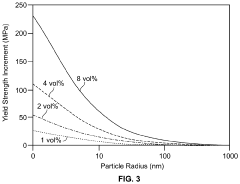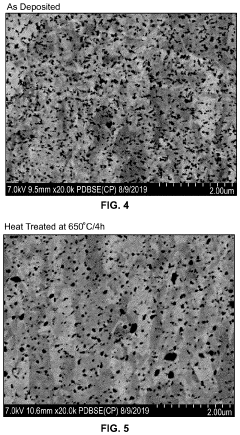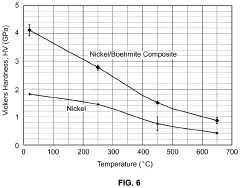Additive Manufacturing-Assisted Electroforming For Fabricating Complex Metallic Structures - Eureka
OCT 10, 20243 MIN READ
Generate Your Research Report Instantly with AI Agent
Supercharge your innovation with Patsnap Eureka AI Agent Platform!
Additive Manufacturing and Electroforming Goals
The primary objective is to explore the potential of additive manufacturing-assisted electroforming for fabricating complex metallic structures. This technology combines the advantages of additive manufacturing (AM) and electroforming, enabling the production of intricate metallic components with high precision and complexity.
Key goals include developing efficient processes for integrating AM and electroforming, optimizing material properties and surface finishes, and addressing challenges related to dimensional accuracy and internal defects. The research aims to unlock new possibilities in fields such as aerospace, electronics, and biomedical engineering, where complex metallic structures with tailored properties are in high demand.
Key goals include developing efficient processes for integrating AM and electroforming, optimizing material properties and surface finishes, and addressing challenges related to dimensional accuracy and internal defects. The research aims to unlock new possibilities in fields such as aerospace, electronics, and biomedical engineering, where complex metallic structures with tailored properties are in high demand.
Market Demand for Complex Metallic Structures
- Growing Demand for Complex Structures
The market for complex metallic structures is expanding rapidly, driven by the increasing need for lightweight, high-strength components in industries like aerospace, automotive, and medical devices. - Customization and Design Flexibility
Additive manufacturing-assisted electroforming enables the fabrication of intricate geometries and customized designs, catering to the demand for personalized and optimized products. - High-Performance Applications
Complex metallic structures produced through this technique find applications in high-performance sectors, such as aerospace turbine blades, automotive engine components, and medical implants, where strength, durability, and precision are critical. - Emerging Markets and Opportunities
The technology opens up new market opportunities in fields like biomedical engineering, energy storage, and electronics, where complex metallic structures with tailored properties are increasingly sought after.
Current State and Challenges in Additive Manufacturing and Electroforming
- Additive Manufacturing (AM) Status
AM has evolved rapidly, enabling fabrication of complex geometries. However, limitations exist in material properties, surface finish, and dimensional accuracy. - Electroforming Challenges
Electroforming allows precise replication but struggles with complex internal features. Challenges include uniform current distribution, electrolyte flow, and mandrel removal. - Geographical Distribution
AM and electroforming technologies are widely distributed globally, with major research hubs in the US, Europe, and Asia.
Existing Solutions in Additive Manufacturing and Electroforming
01 Additive manufacturing methods for complex metallic structures
Various additive manufacturing techniques, such as laser-based, electron beam-based, or arc-based, are used to fabricate intricate metallic structures with complex geometries and features by selectively melting and depositing metal powder or wire layer by layer.- Additive manufacturing methods: Various additive manufacturing methods, such as laser-based, electron beam-based, or arc-based techniques, are used to fabricate complex metallic structures with intricate geometries and features that are difficult or impossible to achieve through traditional manufacturing processes, involving layer-by-layer deposition of metallic materials.
- Support structures for complex geometries: To enable the fabrication of complex metallic structures with overhanging or unsupported regions, various support structures are employed during the additive manufacturing process, providing temporary reinforcement and later removed or dissolved after the part is completed.
- Hybrid additive and subtractive techniques: Combining additive manufacturing with subtractive techniques like milling or machining allows for the fabrication of complex metallic structures with improved surface finish, dimensional accuracy, and the ability to incorporate features challenging to achieve through additive manufacturing alone.
- Topology optimization and lattice structures: Topology optimization techniques are used to design and optimize the internal structure of complex metallic components, often resulting in lattice or cellular structures that provide high strength-to-weight ratios and tailored mechanical properties, which can be fabricated using additive manufacturing methods.
- Multi-material and composite structures: Additive manufacturing techniques are developed to fabricate complex metallic structures incorporating multiple materials or composites, enabling the creation of functionally graded or heterogeneous components with tailored properties and performance characteristics.
02 Support structures for complex geometries
To enable the fabrication of overhanging or intricate features, support structures are employed during additive manufacturing, providing temporary reinforcement and later removed or dissolved after the part is built.03 Hybrid additive and subtractive techniques
Combining additive manufacturing with subtractive methods like milling or machining allows for improved surface finish, dimensional accuracy, and the ability to create features difficult to achieve through additive manufacturing alone.04 Lattice and porous structures
Additive manufacturing enables the fabrication of metallic structures with lattice or porous geometries, beneficial for applications such as lightweight components, heat exchangers, or biomedical implants, with optimized mechanical, thermal, or biological properties.05 Process simulation and optimization
Process simulations and optimization techniques are employed to model and analyze factors like thermal behavior, residual stresses, and distortions, allowing for the optimization of process parameters and support structures to improve the quality and reliability of additively manufactured complex metallic structures.
Key Players in Additive Manufacturing and Electroforming
The additive manufacturing-assisted electroforming industry is growing rapidly, driven by technological advancements and rising demand for complex metallic components. Key players like General Electric Company, Microfabrica, Inc., and Modumetal, Inc. are leading the way with established processes and applications, while academic institutions contribute to research and development.
Microfabrica, Inc.
Technical Solution: Microfabrica specializes in micro-scale additive manufacturing and electroforming technologies, enabling the creation of complex metallic structures with high precision and fine features for medical devices, aerospace, and electronics.
Strength: High precision and fine feature capabilities. Weakness: Limited to micro-scale applications.
General Electric Company
Technical Solution: GE integrates additive manufacturing with electroforming to produce complex metallic components with enhanced mechanical properties and reduced weight, particularly in the aerospace sector.
Strength: Strong industry presence and advanced technology. Weakness: High cost of implementation.
Core Innovations in Additive Manufacturing and Electroforming
Methods of forming high-temperature electroformed components and related components
PatentActiveUS20220081793A1
Innovation
- The ability to efficiently, precisely, and scalably manufacture metal parts through the electrolytic reduction of metal ions on a mandrel. this process, known as electroforming, offers several advantages such as efficiency, precision, and low-cost requirements. however, the limited material options in electroforming may restrict the broader application of this technology for advanced structural components. the background technology highlights the need for improved methods of manufacturing high-performance electroformed components, particularly for advanced structural components in industries such as healthcare, electronics, and aerospace.
Regulatory Landscape for Additive Manufacturing
Additive manufacturing (AM) combined with electroforming offers a promising approach to fabricate complex metallic structures with intricate geometries and high precision. This technology leverages the design freedom of AM to create intricate molds or patterns, which are then used as substrates for electroforming to produce dense, high-quality metallic components. The integration of these two processes enables the production of complex shapes and internal features that are challenging or impossible to achieve through traditional manufacturing methods. By addressing the limitations of individual techniques, this hybrid approach opens up new possibilities for various industries, including aerospace, biomedical, and electronics, where lightweight, high-strength, and geometrically complex metallic structures are in demand.
Environmental Impact of Additive Manufacturing and Electroforming
Additive manufacturing (AM) combined with electroforming presents a promising approach for fabricating complex metallic structures with intricate geometries and enhanced properties. This technology leverages the design freedom of AM to create intricate molds or patterns, which are then used as substrates for electrodeposition of metals. The resulting structures exhibit high dimensional accuracy, superior mechanical properties, and the ability to incorporate multiple materials. Key challenges include optimizing the electroforming process parameters, improving surface finish, and developing efficient post-processing techniques. Potential applications span aerospace, biomedical, electronics, and other industries requiring customized metallic components with complex shapes and tailored properties.
Unlock deeper insights with Patsnap Eureka Quick Research — get a full tech report to explore trends and direct your research. Try now!
Generate Your Research Report Instantly with AI Agent
Supercharge your innovation with Patsnap Eureka AI Agent Platform!



